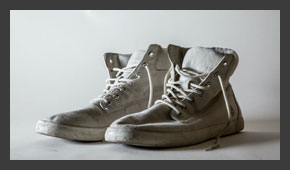Have you ever noticed that one part of your shoe is always wearing down before another part? Maybe one side wears down more quickly than another. If you start to notice this, it could be a sign that the pressure on your feet is being distributed unevenly. For some people this might not be a problem, but for others this could be the reason they have pain in their feet, hips, knees or ankles.
Normal wear and tear
The most common wear pattern that most people believe is abnormal is an increase wear pattern to the bottom heel, pinky toe side. Our heel typically does not strike the ground vertically. It normally strikes the ground with a slight tilt, also known as inverted, supinated or varus position. The human foot is designed to strike the ground supinated, which is the "locked" or stable position of the foot, then as we move forward the foot pronates as ground pressure moves towards the big toe. So, it is normal to see increased wear pattern on the bottom outside heel.
Ill-fitting shoes
Shoes that are too tight or poorly cushioned can lead to small areas of thickened skin called corns or calluses. Corns are small areas of thick skin on or around the toes and calluses are areas of thick skin typically on the bottom of the feet.
Tight toe boxes can cause ingrown toenails and neuromas. Shoe pressure on the tips of toes can irritate the skin surrounding the nail plate causing swelling and redness also known as paronychia. If paronychia will not resolve on its own a surgical procedure called partial nail avulsion may be needed.
Also, a tight toe box can squeeze the long bones in the forefoot pinching a nerve which causes it to become swollen and painful. This condition is known as a neuroma. Neuromas are treated with supportive shoes with wide toe boxes, arch supports and sometimes cortisone injections.
Plantar fasciitis, which is a strain or tear of the plantar fascia on the bottom of the heel, can be caused by wearing shoes that are not supportive enough for a given activity. For example, wearing a flip flop to Disneyland or on a long walk. Always evaluate the sole rigidity of the shoe for that given activity. The higher the foot demand, the more support you will need from the shoe to prevent plantar fascial strain.
Good support is the key to keeping happy feet. The more supportive the shoe provides, the less work your foot does. Adding an arch support or orthotic is also a good idea if you have foot problems. Shoes that have removable liners will make it easier to add an arch support. If you have occasional foot pain and it goes away relatively quickly then you'll probably be ok to continue to wear the shoes of your choice. However, if pain is becoming more constant and it is altering your lifestyle then it may be time to ditch the stilettos and winklepickers.
Written by
Dr. Jeffrey S. Hurless
DPM, FACFAS Board Certified Foot & Ankle Surgeon/Podiatrist
Medical Director, HealthyFeetStore.com
 |
 |
